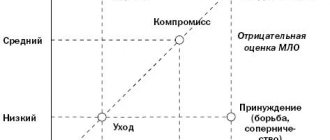Efficiency in management today worries the minds of many people all over the planet: some strive to improve their professionalism, others want to achieve the highest results, others are just preparing to enter a full-fledged adult life and, like a sponge, absorb all kinds of knowledge. Be that as it may, the problem of leadership concerns absolutely every area of life and activity. As for leadership models themselves, there are quite a few of them today. And today we will talk about one of the most interesting and effective of them - Fred Fiedler's model of effective leadership.
But first, let's say a few words about its author.
Mitchell and House's path-goal approach.
According to the approach of Terence Mitchell and Robert House, a leader can motivate subordinates to achieve organizational goals by influencing ways to achieve those goals.
The term path-goal refers to expectancy theory concepts such as effort-performance, performance-reward, and the perceived value of rewards in the eyes of the subordinate. There are 4 leadership styles available:
1. Support style
. Similar to the person-centered or human-relationship style;
2. Instrumental style
. Similar to the work or task oriented style;
3. Participative style
. It is characterized by the fact that the leader shares the information he has with his subordinates and uses their ideas and suggestions to make decisions for the group. There is a strong emphasis on consultation;
4. Achievement-oriented style
. Characterized by setting rather challenging goals for subordinates and expecting them to work to the fullest of their abilities. They are also reminded of the need to continually improve their individual performance levels. Although a manager strives to achieve high performance, he or she at the same time tries to instill in subordinates the confidence that they are capable of high performance.
The leadership style that is most appropriate to the situation and preferred by subordinates depends on 2 situational factors: the personal qualities of subordinates
and
their beliefs that they can influence the external environment
.
When subordinates have a high need for self-esteem and affiliation, a supportive style (i.e., person- or human-relationship-oriented) will be most appropriate. However, if subordinates have a strong need for autonomy and self-expression, they are more likely to prefer an instrumental (task-oriented) style.
Another characteristic that influences the choice of an appropriate leadership style is the subordinate's belief that he or she is capable of influencing the external environment. Individuals who believe that they actually influence their environment prefer a leadership style that involves the participation of subordinates in decision making. Those who believe that they have little influence on the events taking place around them, that these events are controlled by fate or fortune, prefer the instrumental style
The significance of Fiedler's theory
According to Fiedler, relationships-oriented leadership styles are most effective in moderately favorable conditions for the leader. Indeed, in such situations, the manager does not have enough authority to ensure full interaction of subordinates. But unlike an unfavorable situation, here subordinates do not try to look for reasons for indignation. In most cases, performers tend to do what the manager wants them to do if they are told what they are doing and given the opportunity to do what they want. If a manager is very focused on a single task, he may antagonize the performers and thus contribute to the potential disadvantages of this leadership style. This focus on the task reduces the leader's influence.
A leadership style that focuses on relationships is likely to enhance a leader's ability to exert influence. If a leader cares about the well-being of his subordinates, it will actually improve the relationship between the subordinates and the leader. In the case where all subordinates were motivated by some high-level needs, the use of this leadership style can allow the manager to stimulate the interest of all subordinates in some specific, very important work. In fact, that would be just perfect. After all, employees who independently manage their activities reduce the need for strict, strict supervision.
Like many other models, Fiedler's theory is, of course, not without its shortcomings. Moreover, she was unable to get any real support from other theorists. This also has limitations, but this does not mean that it is not useful for management practice. A leadership style that is task-oriented is best suited to more or less favorable situations. In addition, the person-centered style is best demonstrated under moderately favorable conditions. Once Fiedler understood this, he was able to lay some of the groundwork for the subsequent development of the situational approach to management. His approach cautions against the simplistic view that there is a single optimal leadership style regardless of circumstances. Moreover, evidence from numerous studies suggests that the situational approach can have practical implications for the selection, hiring, and placement of managers.
Need advice on your academic work? Ask a question to the teacher and get an answer in 15 minutes! Ask a Question
Leadership styles according to Fiedler
According to Fiedler, the most important factor in successful management is the basic style that each individual leader adheres to. This style can be either task-oriented or relationship-oriented.
To determine the leadership style of each individual manager, Fiedler developed a special questionnaire for the employee who is given the least advantage. The least advantaged employee is abbreviated as “NPS”. This questionnaire includes 16 pairs of so-called bipolar definitions. When filling out the questionnaire, respondents must think about each employee and then describe the one they least enjoy working with. Employees are rated on an 8-point scale containing 16 pairs of epithets.
Fiedler was convinced that the results of filling out the submitted questionnaire made it possible to determine what leadership style was characteristic of each of the respondents. The scientist also argued that if the respondent describes the NPC using mostly positive statements, then he is interested in building favorable relationships with subordinates and colleagues. In other words, if you describe the last person you would like to work with in a positive way, you are a leader who has a relationship-oriented leadership style. On the other hand, if you evaluate the NPC primarily using negative epithets, this will mean that your priority is labor productivity, deadlines and quality of work. This state of affairs means that you belong to that category of managers whose leadership style is task-oriented.
At the same time, Fiedler did not exclude that there may be a small number of people who occupy intermediate positions between the two extremes described above and do not belong strictly to any of the leadership styles.
It is also important to say that Fiedler’s model has another interesting feature: according to the scientist, the prevailing leadership style of a person is unchanged, i.e. will remain the same under any conditions
In short, if you are a relationship-oriented leader, you will follow this style always and everywhere. The same can be said for people who have a task-oriented leadership style.
And only after it has been possible to determine the leadership style, one should proceed to assessing situations and determine the significance of these situations and their influence.
Group Leadership
The success of any organization is directly related to the nature of its leadership. And also with the relationships that develop between managers and subordinates.
In a small group, the role of the leader is to unite its members and direct their activities. He is required to have close personal communication with his immediate environment.
Because a leader, a manager, seeks to control the actions and behavior of other people. He must know the way of thinking of his organization’s employees and anticipate their reaction to his activities.
The emergence of a feeling of “we” in a group is a subjective source of group formation and development. Belonging to a group includes two effects:
- The effect of belonging
- Effect of emotional support
Thus, the feeling of belonging to a group plays an important role in group interaction. It binds group members into a single whole and strengthens their activity aimed at achieving the goal.
F. Fiedler's model of leadership behavior
Fiedler proposed that situational leadership is the relationship between leadership style and the characteristics of the situation at hand. He was the first to propose presenting situational variables, of which there are only three, in the form of a scoring system:
- relationship between manager and subordinate (the level of trust of employees in the boss);
- task structure (degree of clarity of work tasks set by the manager);
- official powers of the manager (reflects the degree of formal power granted to the manager).
The maximum score is 8, the minimum is 1. Depending on the points given on the schedule, you can determine a suitable leader to complete the task.
Fiedler's leadership theory
Definition 1
Fred Fiedler is the founder of situational leadership theory.
The leadership model, which he began working on around the 1960s, helps people predict the performance of a group led by a leader.
The most important idea of this approach to leadership was the assumption that the actions of one or another leader must necessarily differ in different situations. This model is based on three situational variables that are needed to determine the degree to which a situation is favorable or controllable for a particular leadership style. An 8-point scale was used to construct the least preferred employee (colleague) profile (LPR).
Finished works on a similar topic
- Coursework Fiedler's Theory of Leadership 450 rub.
- Abstract Fiedler's Theory of Leadership 260 rub.
- Test paper Fiedler's Theory of Leadership 250 rub.
Receive completed work or specialist advice on your educational project Find out the cost
Note 1
According to Fiedler's theory, a person's leadership style remains relatively constant and does not change much from situation to situation because style reflects the basics of individual motivation: motivation for relationships and motivation for work.
The favorability (controllability) of a particular situation can be considered in this model as the degree to which a given situation allows the leader to control it and influence his followers.
Situational Variables:
- team relations;
- structuring the material;
- authority.
Relationships in the group (leader-follower relationships): good-bad - this variable expresses the degree of loyalty, trust, support and respect, that is, the leader’s acceptance by his followers. After all, only by accepting the leader can the follower do everything possible to achieve his goals.
Structuring of material, which expresses the degree of structuring of problems solved by the group.
Do you need to select material for your study work? Ask a question to the teacher and get an answer in 15 minutes! Ask a Question
Here the variable is measured by the following criteria:
- clarity of the goal;
- multiple means to achieve goals;
- reasonableness of decisions;
- specifics of the solution.
Highly structured work helps a leader control performers better and more effectively.
Power (official): strong-weak. It expresses the degree of formal power of a leader necessary to use adequate incentive methods associated with rewarding good and punishing bad employees.
All these situational variables, together with the two leadership styles, form eight types of situations, after analyzing which Fiedler was able to formulate some conclusions.
Good efficiency is achieved when:
- in a not very good situation, leaders are able to reflect the style that is work-oriented (low CPD style);
- in a situation of moderate favorability, a management style that is aimed at relationships is usually achieved (high NPR style). Here all tasks are structured, but the leader's position is usually weak. It is clear that in such a situation the leader is simply forced to be interested in the emotions and desires of his subordinates;
- in the most advantageous, favorable situation, a working style is observed (a style with low NPR).
Fiedler believes that, although each individual situation has its own leadership style, the style of the leader as a whole still remains unchanged.
Since Fiedler assumes that an individual cannot adapt his own leadership style to any particular situation, he suggests creating situations for the leader that best suit his stable leadership style. This will ensure the right balance between the demands of the situation and the personal qualities of the manager, which will lead to high productivity and satisfaction with the result.
The practical significance of the model is that it allows you to select a suitable leader depending on the situation. In this case, the main selection criterion is the correspondence of the manager’s style to the specific production situation. The model also offers a way to change the situation if for some reason it is impossible to change the leader.
Goals and objectives of situational leadership
The main goal of situational leadership is to choose the optimal leadership style for each employee. Every person has a character, a certain mindset, experience and set of skills. To quickly resolve emerging problems, it is necessary not only to involve the right employee in the solution, but also to competently manage him.
Tasks of situational leadership:
- carrying out an analysis of the situation depending on the organization’s requirements in the current situation;
- choosing the optimal approach to management, which to a greater extent and best meets the requirements put forward to the company in a given situation;
- creating a flexible leadership style in the organization that is appropriate to the situation;
- making the necessary changes to manage people and situations effectively.
Trait theory of leadership
It is also called the theory of leadership qualities. One of the first approaches in trying to study and explain leadership. According to this theory, leaders are not made, they are born!
Researchers believed that there was a consistent set of qualities that distinguished “great people.” Scientists have tried to learn how to measure these qualities to identify leaders.
In an attempt to summarize the hundreds of studies that have been conducted. Ralph Stogdill in 1948 and Richard Mann in 1959 grouped leadership qualities. And we identified five main ones:
- Self confidence
- Knowledge of the matter
- Intellectual abilities
- Dominance over others
- Activity and energy
However, these five qualities did not fully explain the nature of the emergence of a leader. Many people with these qualities remained followers rather than leaders.
Situational leadership theory
This theory was born as a result of many years of observations by American psychologists who, in an effort to understand what effective management is, observed, recorded and analyzed how effective and ineffective managers performed their daily tasks. After processing the data obtained, a stunning result was obtained: only the leader who has such a managerial quality as leadership is effective. Only a leader can be an effective manager, regardless of management style, task characteristics and other conditions.
The authors of the theory defined leadership as the ability to use available resources (including human ones) to obtain results. Thus, leadership became the subject of psychological analysis. Currently, there are quite a large number of leadership concepts. However, the theory of “situational leadership”, which we will now consider, is classical and is directly related to management activities. What is the essence of the theory?
The authors of the theory, P. Hersey and K. Blandad, proceeded from the following positions.
- Leadership is a way of interaction between a leader and a team. However, not every way of interaction between an individual and a group is leadership. The leader will be only the manager whose leadership style is most suitable and corresponds to the level of development of the group.
- There are four levels (stages) of group development. Each group, provided it is skillfully led, can reach the highest stage of its development. What are these stages?
group unable and unwilling to work (A level);
- group, receptive (partially willing), but unable to work (level B);
- group willing and partially able to work (B level);
- fully capable and willing to work (G level).
- “Pointing” (for group A level);
Text of the book “Psychology of Leadership. From a behavioral model to a cultural-value paradigm"
Fiedler considers leadership style to be an innate characteristic, and therefore his model provides two ways to improve leader effectiveness. First, the leader can be selected according to the existing organizational conditions. Just as a football coach releases a new player after seeing a change in the nature of the game, an organization assigns a manager with a leadership style that is more appropriate to the situation.
Rice. 1.3.
F. Fiedler's leadership model
Secondly, the situation itself can be changed, for example, by restructuring the group task or expanding / reducing the leader’s power. To illustrate, imagine that a task-oriented leader is in situation IV. If his authority is expanded, he will actually find himself in a new situation - situation III, where the correspondence between leadership properties and the characteristics of the situation will be more favorable for the effective functioning of the group. Empirical studies confirm the high predictive power of the model for situations I, IV, V and VIII (Miner, 1980). At the same time, this model faces serious difficulties in assessing situational variables, does not take into account the characteristics of subordinates, does not take into account the level of professionalism of the leader and the group, and, finally, many questions are raised by the theoretical and psychometric foundations of the LPC questionnaire. However, Fiedler's leadership model is still very popular today. She played a significant role in stimulating research interest in situational factors of leadership.
Situational theory of leadership by P. Hersey and C. Blanchard.
One of the most famous applied models of leadership is the situational theory of P. Hersey and C. Blanchard (Hersey, Blanchard, 1974, 1982). It is used as the main method of training management personnel in such well-known companies as IBM, Mobil Oil, Xerox, as well as in officer training.
This theory focuses on the leader's subordinates, or followers. According to it, the success of a leader depends on an adequate choice of leadership style, which must correspond to the degree of maturity of the members of the group he leads.
The emphasis on subordinates or followers is due to the fact that they are the environment that accepts or rejects the leader. After all, no matter what a leader does, his effectiveness is based primarily on the actions of his subordinates. And, oddly enough, this critical factor has long been ignored in many leadership theories.
The maturity of a group refers to the ability and desire of its members to take responsibility for their behavior. The concept of “maturity” includes two components: professional maturity and psychological maturity. The first component covers the professional knowledge and skills of subordinates. A professionally mature individual has the knowledge, skills, abilities and experience that allow him to perform his professional tasks without anyone's guidance and instructions. Psychological maturity is determined by the desire or motivation to do one's job. People who are psychologically mature do not require external stimulation and encouragement; they are internally motivated.
Hersey and Blanchard also identify two leadership styles: people-oriented and task-oriented. By combining the different expressions of these styles, they come up with four specific leadership styles:
1) “Directive” (strong expression of task orientation + weak expression of orientation towards people). The leader defines the roles of subordinates and specifies what, how, when and where to do.
2) “Supportive” (strong task orientation + strong people orientation). The leader implements both directive and supportive behavior (apparently, a style close to J. Misumi's PM leadership).
3) “Participant” (weak expression of task orientation + strong expression of orientation towards people). The leader and subordinates jointly participate in decision making, with the leader primarily playing the role of moderator[4] 4
Moderator - a participant in a group discussion, performing the function of a moderator (from
the English
moderator - mediator, arbiter, presenter, chairman of the meeting).
[Close] and coordinator.
4) “Delegating” (weak expression of task orientation + weak expression of orientation towards people). The leader is inactive, provides minimal guidance and support to subordinates[5] 5
Our proposed translation of the names of the first two leadership styles largely reflects the substantive characteristics of the terms, but does not fully convey their rhetorical charm, which is so important in the work of management consultants (who are the authors of the theory under consideration). Therefore, I consider it appropriate to give their English version with a literal translation: “directive” - telling (speaking, pointing); “supporting” – selling (selling).
[Close].
Another component of the theory under consideration is the identification of four stages of group maturity:
M1.
Members of the organization (group) are unable and unwilling to take responsibility for their work. They lack both professionalism and self-confidence.
M2.
Members of the organization (group) are not capable, but want to complete the assigned work. They have motivation, but lack the appropriate professional skills.
M3.
Members of the organization (group) are capable, but do not want to do the work proposed (assigned) to them by the leader.
M4.
Members of the organization (group) are both able and willing to perform the assigned work.
The relationship between the elements of the situational leadership theory of P. Hersey and C. Blanchard is presented in Figure 1.4.
According to the model, leader behavior directly depends on the maturity of the group. As subordinates reach higher levels, the behavior of an effective leader is characterized not only by a decrease in control over the group, but also by a decrease in the leader’s influence on the system of interpersonal relations. At stage M1
subordinates require clear and specific instructions.
If the group is at stage M2,
the leader needs to demonstrate a high level of both task and people orientation.
The first will compensate for the lack of necessary knowledge and skills among subordinates, the second will remove the group’s resistance to the pressure of the leader. At stage M3
, motivation becomes the main problem in group activities, and the leader’s people-oriented behavior largely helps solve it.
And finally, at the M4
, the leader does not need to actively influence his subordinates, since they can already work independently, possessing both high motivation and high professionalism.
Rice. 1.4.
Situational leadership model proposed by P. Hersey and C. Blanchard
It is easy to see that the Hersey-Blanchard situational theory of leadership is in some respects similar to the Blake-Moton management grid. Thus, the directive style is in many ways similar to the authoritarian style 9.1, the supportive style is similar to the 9.9 style, etc.
Nevertheless, the inclusion of a group context qualitatively changes the content of this typology. Style 9.9, which was considered by R. Blake and J. Mouton as the best for all cases of management, in the situational theory of Hersey-Blanchard acts only as one of the possible styles, the effectiveness of which is determined by the degree of maturity of the group. The validity of the theory has been confirmed by a number of researchers (Hambleton, Gumpert, 1982; Graeff, 1961).
Tannenbaum–Schmidt continuum of leadership behavior.
A. Tannenbaum and W. Schmidt (Tannenbaum, Schmidt, 1973) tried to find the correspondence of leadership styles to various conditions developing in the organization. Leadership styles, in their view, are not discrete, but represent a continuously changing continuum - from authoritarian leadership focused solely on work to leadership completely focused on relationships with subordinates. Leadership styles vary depending on the degree of freedom that managers give their subordinates. According to the authors of the model, between these two poles there are five more intermediate leadership styles.
Rice. 1.5.
Leadership Behavior Continuum
At the same time, the success of the applied leadership style depends on four organizational and psychological variables:
1. The personality of the leader and his preferred style;
2. Personal and professional qualities of subordinates;
3. Goals, requirements and content of the work performed;
4. Situational factors related to the culture and characteristics of the organization. The style chosen by the leader is a function of these variables. The continuum of leadership behavior, in accordance with the Tannenbaum-Schmidt model, is presented in Figure 1.5.
Model of “movement towards a goal” (Path-goal theory) by R. House and T. Mitchell.
This model is focused on predicting leader effectiveness in various situations. According to the goal-driven model (DKM), high employee satisfaction and effectiveness are possible only if there is an adequate connection between their efforts and work results, as well as between work results and rewards. Moreover, the effectiveness of leadership is directly related to the level of motivational power possessed by the expectations of followers. Ideally, the reward should be fully consistent with the result. An effective leader can only be one who provides subordinates with the opportunity to move towards their goals (Evans, 1970). At the same time, the leader must clearly formulate the task for its successful implementation (House, 1971; House, Mitchell, 1974).
House and Mitchell identified four leadership styles: directive, supportive, participative, and goal-oriented.
Directive style - a high level of work structuring, explaining to subordinates what
and
how
to do it, as well as
what
and
when
they are expected to do.
Supportive style - pays close attention to the needs of employees and their well-being, develops a friendly work environment and treats subordinates as equals.
Participative style - consultation with subordinates and attention to their suggestions and comments during decision-making, involving subordinates in participation in management.
Goal-oriented style - setting intense but attractive goals, great attention to quality in everything, confidence in the capabilities and abilities of subordinates to achieve a high level of work performance.
For effective leadership, the leader's knowledge of how followers/subordinates perceive his behavior is important. Here the authors propose to take into account three aspects: satisfaction with the result of job performance, positive or negative perceptions of the leader's behavior and the expectation of appropriate reward for their activities (House, Dessler, 1974). A directive leader strives to make clear to subordinates what is expected of them. A supportive leader views his subordinates as equal partners. A participative leader consults his subordinates and considers their suggestions and ideas before making a decision. A goal-oriented leader sets inspiring goals and expects his subordinates to perform effectively and professionally.
A number of studies have assessed the validity of the DCC model (Keller, 1989). The results showed a strong relationship between a leader's desire for clarity and subordinates' satisfaction. The more clearly the tasks are set for subordinates, the more positively they perceive the leadership style of their leader.
Research has shown that all four behaviors can be practiced by the same leader in different situations. The leader must help subordinates understand realistic expectations and reduce obstacles to achieving desired goals. An effective leader strives to clearly define the path of subordinates to goals, choosing and applying the style of behavior that best meets the specified task. Thus, DCC requires the leader to use the style that is most appropriate in a given situation.
The House-Mitchell model also takes into account two groups of factors that influence the effectiveness of a particular leadership style. These are the personal characteristics of followers/subordinates and external organizational conditions.
An important personal characteristic of followers/subordinates is their assessment of their abilities, the presence or absence of experience, as well as the individual’s level of confidence/uncertainty in the ability to control the course of their life (locus of control). Thus, the higher followers/subordinates rate their ability to perform a task, the more difficult it is for them to accept the leader's directive style. In such situations, this leadership style can negatively affect their performance. Individuals with an internal locus of control (believing that rewards are determined by their efforts) tend to be more satisfied with a participative style, while those with an external locus of control (believing that the amount of reward is controlled by external factors) tend to be more satisfied with a directive style (House, Mitchell, 1974).
As external factors influencing the effectiveness of a particular leadership style, House and Mitchell identify: 1) the content and structure of the work; 2) the formal system of authority in the organization and the characteristics of the work group, its dynamics and norms.
Thus, a formalized task with a rigid algorithm of activity largely makes a directive leadership style unnecessary, and a rigid hierarchical organizational structure will conflict with a participative style of behavior. In general, as shown in Figure 1.6, the effective implementation of a particular leadership style must take into account the entire set of situational variables included by House and Mitchell in the DCC model.
Rice. 1.6.
Model of “movement towards a goal” (DKT) by R. House - T. Mitchell
Attributional leadership model.
Attributional leadership theory emphasizes that it is associated with cognitive processes in which the leader interprets the behavior of subordinates based on certain “cues” in the context of the existing organizational environment (Kelley, 1967). In many cases, determining the reasons for the behavior of followers/subordinates is based on some subjective assumptions formed on the basis of the characteristics of individual perception. The attributional model assumes that the leader is essentially an information “processor” (Green, Mitchell, 1979), that is, he looks for an information signal about “why” something happened, and then tries to formulate an explanation that largely determines his behavior as leader. Identifying the reasons for the behavior of subordinates comes down to classifying them into one of three categories by which it can be determined: 1) to the personal characteristics of subordinates; 2) to the essence of the matter, 3) to the context of the situation. So, trying to understand the reason for the decline in product quality, the leader considers the following alternatives: the human factor (whether the employees are to blame or not), the specifics of the task (whether the task was difficult to complete), the result of a combination of certain circumstances (context).
When attributing the causes of a follower's behavior, the leader relies on three types of information: consistency, consistency, and consistency. In the first case, the leader will try to determine whether other employees behave similarly in similar situations. It then assesses consistency, that is, whether a particular employee always behaves in a similar manner in similar situations. Finally, the leader evaluates how consistent/inconsistent the employee's behavior is: whether he behaves differently in different situations (Figure 1.7).
Thus, using attribution theory, it is possible to predict the leader's reaction to the actions of followers (Mitchell, Grenn, Wood, 1981). Attribution bias is the tendency to favor one explanation for behavior over another. The fundamental attribution error occurs when a person or situation is judged on the basis of limited information. When information is incomplete, it is preferable not to make a judgment at all.
In the actual activities of leaders, there is a tendency to place too much emphasis on personality or dispositional criteria. At the same time, people tend to underestimate or ignore situational factors.
In recent decades, management and organizational psychological literature has given preference to collegial and democratic procedures for solving problems and making decisions (the so-called participative, “participating” management). The Japanese success in introducing quality circles has made various forms of employee participation in organizational decision-making even more popular. Many even have the impression that active employee participation is always and in all situations more effective than individual decisions or an authoritarian leadership model. In fact, as has been noted more than once, everything is not so simple: a rigid authoritarian leadership style is not always bad, and weakening management control is not necessarily productive.
Vroom and his colleagues proposed a promising and potentially effective approach to assessing certain situational variables and their relationship with alternative decision-making procedures and leadership styles (Vroom, 1973; Vroom and Yetton, 1973; Vroom and Yago, 1978).
Rice. 1.7.
Main determinants of the attributional process
The model they propose is normative in nature, as it prescribes the implementation of a set of consistent rules that allow one to determine the optimal leadership style based on various situational variables. The purpose of the model is therefore to diagnose the most appropriate leadership style. It allows the leader to take into account alternative decision-making procedures (authoritarian, consultative, participative) and choose the one that is most suitable for a given situation (Table 1.4).
As can be seen from the table, AI and AII represent decisions consistent with the authoritarian (A) leadership style, and neither of them involves real participation of subordinates. In the first case, the leader makes decisions independently, using the information he has. In the second, he receives information from subordinates, but makes decisions alone.
Subordinates participate in decision making only as a source of necessary information; they are excluded from searching for or evaluating alternative solutions.
Leadership styles KI and KII are assessed as consultative (K). Their difference is that the leader either consults with each of the followers individually, without gathering them into a problem group, or consults with the group as a whole, and then makes a decision himself, which may or may not reflect the opinions of the subordinates. Here there is a higher degree of involvement of subordinates in the decision-making processes than in the first two, and the degree of control of the manager over the problem and its solution is lower.
GII is a group, or participative, leadership style that involves a significant degree of involvement of subordinates in the decision-making process.
Here the leader presents the problem to the group, and as a result of joint discussion, alternative solutions are sought. Trying to reach an agreed decision, the leader does not impose his opinion, but makes the decision that the group has chosen.
The effectiveness of each of these styles depends on the specific situation and the nature of the problem that needs to be solved. The model under consideration identifies three main groups of variables that must be taken into account when determining whether a given leadership style will lead to effective problem solving and desired results:
Table 1.4
Leader behavior styles in the decision-making process
• requirements for the quality of the solution;
• the degree of approval and commitment of those led to the decision made, which is considered as a factor in the effectiveness of implementation;
• time allotted for making a decision.
Researchers have proposed a set of situational characteristics, or “problem properties,” and associated diagnostic questions (see Table 1.5).
Associated with these properties and issues is a set of rules used to select alternative leadership styles (when solving problems and making decisions). The rules are designed to ensure the quality of decisions (rules 1, 2 and 3) and their approval by subordinates (rules 4, 5, 6 and 7).
1. Information Rule:
if the quality of the solution is important and if the manager does not have sufficient information or knowledge to independently solve the problem, AI is excluded from the admissible set. (If you use it, there is a risk of getting a low-quality solution.)
2. Goal compatibility rule:
if the quality of the solution is important, and subordinates do not share the organizational goals that will be achieved by solving the problem, GII is excluded from the admissible set. (Alternatives that remove the manager's final control over the decision may compromise the quality of the decision.)
3. Unstructured problem rule:
in cases where the quality of the decision is important, the manager does not have the necessary information and knowledge to make an independent decision, and the problem is not structured, the decision-making procedure must provide not only the receipt of information, but also an economical and effective way of collecting it.
Methods involving the interaction of subordinates with comprehensive knowledge of the problem in this situation are likely to be more economical and provide a high quality solution to the problem. Under these conditions, AI, AII and KI are excluded from the admissible set. (AI does not ensure that the manager receives the necessary information; AII and CI are more cumbersome and less efficient and economical ways of collecting the information necessary to solve the problem.)
Table 1.5
"Problem properties" used in the model
4. Approval Rule:
If the approval of a decision by subordinates is important for its effective implementation, but it is unclear whether the authoritarian decision made by the manager will receive approval, AI and AII are excluded from the admissible set. (Neither of these methods allows subordinates to participate in the decision, and both compromise necessary approval.)
5. Disagreement Rule:
if approval of the decision is important, and conflicts or disagreements may arise among subordinates regarding the decision made, AI, AII, KI and KII are excluded from the permissible set. (Problem-solving methods should be capable of resolving disagreements in solving the problem. Accordingly, in such circumstances, AI, AII and KII, which do not provide the opportunity to resolve differences, are excluded. When using these methods, there is a risk that some subordinates will not be sufficiently committed to the final solution.)
6. Rule of fairness:
if the quality of the decision is not important, and the main point is approval, but it is not known whether the authoritarian decision will be approved, then AI, AII, KI and KII are excluded from the admissible set. (The method is intended to maximize the likelihood of approval, since this is the only significant consideration determining the validity of the decision. Under these conditions, AI, AII, KI and KII are excluded from the acceptable set. Their use would jeopardize obtaining the necessary approval.)
7. Approval priority rule:
if approval is important and it is not provided with an authoritarian decision, and subordinates can be trusted, then AI, AII, KI and KII are excluded from the admissible set. (Methods that ensure equal participation of subordinates in the decision-making process can generate a higher degree of approval without compromising quality. Using any method other than GII carries the unnecessary risk that the decision will not be fully approved or that subordinates will not will be duly committed to it.)
In this model, the results of certain problem-solving and decision-making procedures depend primarily on the first two groups of variables. The time variable primarily influences the choice of leadership style when two or more styles are appropriate for a given situation.
In order to formalize the decision-making algorithm, the authors proposed using a “decision tree” (Figure 1.8).
To choose the appropriate leadership style, you need to go along the entire “decision tree” using the given rules. For example, if the answer to question A is no, then the next step requires moving to question D. If the answer to this question is also “no,” then the decision tree leads us to end point 1.
For many problem types, multiple styles can be used successfully. However, if there are strict time constraints, then the most optimal style is one that ensures maximum speed of decision-making.
Rice. 1.8.
Scheme of a leader’s solutions to emerging problems (according to V. Vroom)
There are 14 types of solutions, each of which reflects a specific problem situation. All of them are presented in table 1.6. For example, type 2 characterizes a situation where it is not the quality of the decision that is of primary importance, but its approval by subordinates. According to the theory, the choice of AI leadership style in this situation will be the most optimal.
W. Vroom and his colleagues concluded that approximately 30% of the variation in leadership style arises from the situation and only about 10% is associated with individual preferences. There is evidence that more successful leaders and managers are adept at adapting their style to suit changing circumstances. This model serves as a useful diagnostic tool in determining the most appropriate style and provides a more thorough diagnosis of the situation for which a participatory strategy is truly appropriate.
Vroom et al.'s model helps to understand how subordinates are involved in the decision-making process. It ascends from the individual actions of the leader (subordinates are assigned exclusively to the role of performers) through joint consultation of the leader and followers and expertise - to various forms of group leadership, when decisions are made and implemented at the group level by all its members.
Table 1.6
Problem types and admissible set of decision-making procedures
Note:
* Within the admissible set, if the answer to question F is positive.
The model consistently emphasizes the decisive role of the situation in choosing the optimal leadership style. In a certain sense, the model allows us to say that it is situations rather than the leaders themselves that are authoritarian or participatory.
And one of the main tasks of a leader is to correctly diagnose these situations.
The normative model has found both supporters and critics (Hampton, Summer, Weber, 1982; Fields, 1979; Hill, Schmidt, 1977). However, in any case, it is a useful tool that helps leaders understand the specifics of the decision-making process and develop optimal options for their implementation (Baker, 1980).
When leadership is unnecessary
An analysis of situational leadership theories demonstrates the importance of fit between a leader's behavior and a specific situation. But there are situations where leadership does not play any positive role at all. Research shows that under certain conditions, no matter what style of behavior a leader demonstrates, it will be inadequate to the situation. Certain organizational variables can act as “substitutes” for leadership or completely neutralize the leader’s attempts to influence his subordinates (Kerr and Jermier, 1978; Howell and Dorfman, 1981; Howard and Joyce, 1982).
For example, the presence in subordinates of such characteristics as a high educational level, professionalism, experience and the need for independence actively neutralize the manager’s aspirations to become a leader in the group he leads. Strictly regulated, routine activities or, conversely, creative work, in turn, make the phenomenon of leadership largely unnecessary. In the first case, the efforts of the manager are largely replaced by clear goals, formalized procedures and methods of activity, acting as a form of management control and organization of employee behavior. In the second, the nature of creative activity, largely determined by the internal motivation of the individual, requires self-government rather than external influences.
Factors that neutralize leadership.
A number of studies have found that, under certain conditions, leadership in any of its manifestations not only does not have any positive impact on the effectiveness of activities, but also complicates and disorganizes the work of subordinates (Howell et al., 1981; Kerr, Jermier, 1978 ). Certain factors tend to neutralize a leader's ability to increase or decrease a subordinate's performance. For example, work on a conveyor belt is solely determined by the pace of movement of the conveyor itself and the specific operation that is assigned to the worker. Attempts to additionally influence this process on the part of the leader are more likely to interfere with activity than to optimize it. However, as a rule, these points are ignored in theories.
S. Kerr and J. Jermier (Kerr, Jermier, 1978) examined variables in which changing leadership style had no effect on their performance or their level of job satisfaction. Such variables are called leadership substitutes; their relationship with the need to use a particular leadership style is presented in Table 1.7.
Table 1.7
Leadership Neutralizers
So, we have traced the history of identifying leadership as a subject of psychological research and summarized the achievements of modern psychology in the study of this phenomenon. It has been shown that the most popular among researchers and practitioners is the behavioral approach, within which the basic factors that ensure the effectiveness of leadership behavior have been identified: the first links together those actions through which the leader ensures the achievement of the group’s goals; the second emphasizes the leader’s efforts in forming harmonious interpersonal relationships in the group. The degree of actualization of these factors made it possible to identify different styles of leader behavior, while most researchers came to the conclusion that the leadership style in which both factors are expressed to the maximum is the most effective. Subsequently, the two-factor model came to dominate leadership research, and on its basis, numerous trainings and management education programs were created, which are still successfully used by many organizations.
It has been demonstrated that, despite the widespread use of the concept of leadership in all areas and at all organizational levels, its scientific research is still carried out exclusively at the group level; the behavioral approach, largely devoid of mental and value content, dominates. In this regard, there is an urgent need to overcome “group-centrism” and move to the study of leadership in a broad organizational context.
An analysis of the current state of leadership research shows that, despite significant achievements (primarily applied ones), the scientific development of the problem of leadership does not correspond to the role and significance that it de facto has in the organization. In fact, leadership does not act as an important organizational process associated with the strategic goals and resources of the organization, but as one of many independent variables, such as personality, motivation, values, abilities, etc. In modern approaches, leadership is viewed either as a specific set of personal properties , either as a technology of behavior, or as the interaction of specified properties and behavioral reactions with a limited set of situational variables. The holistic image of a leader is replaced by a mechanical set of traits, reactions and variables, behind which the internal, mental content of this phenomenon is lost. With this view, in essence, the leader’s subjectivity is lost, and due attention is not paid to his consciousness as the highest form of mental reflection.
Blancher Hersey Life Cycle Concept
The main idea of the concept is mutual interaction between employees and managers. The employee must desire professional growth, and the leader must correctly use situational approaches to effective leadership.
In their concept, Blancher and Hersey believe that the choice of one of 4 leadership styles (authoritarian, mentoring, friendly and delegating) directly depends on the level of development of the subordinate.
In their theory, Blancher and Hersey use two criteria to determine the level of an employee: enthusiasm (motivation) and professionalism. Employee development levels were first introduced in Ken Blancher's book, The One Minute Manager and Situational Leadership.
Employee development levels:
Motivated, but not professional. As a rule, this category includes young employees who have recently started work. Their level of passion is great, but they also lack some knowledge and experience. In relation to such an employee, you need to use a directive management style. Lack of motivation and professionalism. Most often, this is the second stage of novice workers, which begins after several unsuccessful attempts or mistakes in work. In this case, it is necessary to use a mentoring style, help the employee and take into account his opinion. Lack of motivation despite having sufficient skills. Employees experiencing professional burnout or problems outside of work fall into a state of a certain apathy towards work.
In this case, a friendly leadership style, support and attention to the employee, and the opportunity for him to feel needed at work are suitable. High motivation and professionalism
Such employees are a godsend for any manager, since they can not only do their work efficiently, but are also able to help other lagging colleagues. In this case, the style of delegation of authority is suitable.
Leadership based on the emotional intelligence model
This concept is considered the youngest; it was developed by D. Goleman, a professor at the University of Chicago in 1980-90.
20th century. According to this concept, effective leadership means managing the emotions of other people. A leader with high emotional intelligence has the ability to recognize and manage their own feelings and the feelings of others.
Skills and competencies of a leader with high emotional intelligence:
Awareness of one’s own feelings is the ability to notice and be aware of one’s feelings, to subtly differentiate them.
Managing your own feelings - the ability to cope with destructive impulses and control negative emotions; flexibly adapt to the situation, “tune” yourself in the right way - to win, win, etc.
Awareness of the feelings of another person - the ability to show empathy (empathy for the feelings of other people), understanding and being sympathetic.
Managing the feelings of other people - the ability to have an emotional impact in various situations of interaction with subordinates, influence and inspire, resolve conflicts, create a team and strengthen team spirit, strengthen and maintain personal relationships with employees, help others in self-improvement, initiate changes and lead employees in new ways direction.
From the point of view of leadership theory, the emotional intelligence model suggests that a leader pay attention to the development and improvement of all four abilities associated with the awareness and management of emotions and feelings. This theory is confirmed by a number of practical studies.
Leadership styles and their effectiveness
The situational leadership style presupposes effective mastery of 4 main management styles that the manager uses to manage personnel, combining or dividing them in relation to different employees.
Management styles:
- Directive (authoritarian). This style of leadership is characterized by a high level of control by the boss over his subordinates, clear issuance of orders, and a high level of punishment of the employee for mistakes. This style is effective in solving crisis problems that require quick and unambiguous action, and is well applicable to quarrelsome employees.
- The mentoring style involves allowing employees to take initiative and express their thoughts. The manager holds regular meetings with employees, helps and mentors in solving complex problems. The level of control is high. The style is good for proactive young employees who are ready to develop in their profession.
- A friendly (supportive) leadership style is aimed at helping the employee, the degree of control is minimal. Effective as a situational approach to leadership in combination with other styles. “The carrot and stick method” is a combination of friendly and authoritarian styles.
- The delegating (reference) style presupposes complete freedom for the employee to solve problems; all responsibility for implementation also lies with the subordinate. This leadership style is only applicable to highly qualified and highly motivated personnel.
A competent combination of styles is situational leadership, which ensures a high level of personnel management efficiency.
What criteria are used to evaluate the manager’s compliance with the team?
Below I will discuss how management style relates to team performance.
Situation 1
The most favorable for a manager, as it is characterized by structured tasks, greater authority and favorable relationships with colleagues. It is in such conditions that it is possible to have maximum influence on subordinates. But it practically never occurs.
By the way, you can take a test of cohesion in your team.
Situation 8
Least favorable, since the manager has minimal authority, poor relationships with colleagues, and there is no clear structure in the tasks.
But F. Fiedler says that despite the colossal difference in situations 1 and 8, in such teams the autocratic management style is equally effective.
In a team that is interested in efficiently completing tasks, there is a high speed of productivity and decision-making combined with strict process control. Therefore, the autocratic style is successful where performers listen to their manager.
If the leader has little or no power or authority, then the authoritarian style is best suited. With its help, it is possible to organize direct control of subordinates and correct their actions if necessary.
Situations 1, 2, 3
In situation 1-3, there is initially a good relationship between the manager and subordinates, so there is no need to build and maintain them. Also, the success of these situations is predetermined by the routineness of tasks and the authority of the manager, so the duty of colleagues is typical here.
Adherents of the non-directive style passively lead the team, although employees are not averse to carrying out new assignments. Managers do not fully use all their opportunities for influence and have good relationships in the team.
A manager should clearly understand that there is a big difference between being task-oriented and humiliating your colleagues. Being a dictator, he risks having an indignant team that does not want to come to an agreement and joins informal groups whose goals are at odds with the organization’s strategy. This is followed by losses in management efficiency.
Situation 4, 5, 6
The leader prefers to be people-oriented. This allows you to build trust with employees and thereby increase their desire to interact. For example, he may begin to show concern for his subordinates. Uses high-level motivational methods and motivates colleagues to perform specific tasks. This reduces the need for close supervision and minimizes the risk of losing control over workers.
Under the same conditions, an autocratic leader has significantly less chance of success in organizing productive work in this team.
Fred Fiedler's Model of Effective Leadership
Fred Fiedler's model of effective leadership, also called the situational model, is based on the fact that the effectiveness of the team depends largely on the extent to which each individual situation allows the leader to exercise control over his employees and influence their work.
The main idea of this model is that different leadership styles will be most effective in different conditions. In this regard, several leadership styles and different situations were identified, and the most optimal combinations of these two components were compiled.
In order for Fiedler's model to be understood most fully, we must first consider its first component - leadership styles.
Leadership in management
Leadership is not management. Management focuses on getting people to do things right. And leadership is about getting people to do the right things.
| Manager | Leader |
| 1. Administrator | 1. Innovator |
| 2. Instructs | 2. Inspires |
| 3. Works on the goals of others | 3. Works according to your goals |
| 4. Uses arguments | 4. Uses emotions |
| 5. Controls | 5. Trusts |
| 6. Professional | 6. Enthusiast |
| 7. Makes decisions | 7. Turns decisions into reality |
| 8. Does the job right | 8. Does the right thing |
| 9. Respect | 9. We love it |
| 10. Action plan | 10. Vision is the basis of action |
| 11. Relies on the system | 11. Relies on people |
| 12. Supports movement | 12. Gives momentum to movement |
Research has shown that a significant group of managers have leadership qualities. However, the opposite option is very rare in real life.
Brief summary
The researchers were able to obtain a sufficient number of documentary evidence of the key points of Fiedler's model. But despite this, the model also has some disadvantages. First, to fill out the questionnaire, the researcher must have data, which is quite difficult to collect. Secondly, the very practicality of the questionnaire raises doubts, because the same respondents may give different assessments after some time. Thirdly, the hypothesis about the inability of a leader to change his basic style, depending on the situation, does not look entirely realistic.
But in any case, Fiedler's ideas served as a warning against the simplistic view that there can be a specific management style that is independent of circumstances and suitable for any situation. In addition, research data conducted by many scientists show that Fiedler's situational model can be effectively applied in practice in the selection, hiring and placement of managers. There is no doubt that Fiedler's model has made, and still makes, enormous contributions to the understanding of leadership concepts.









